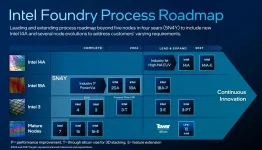Intel plans to release its Nova Lake platform in 2026 and start making chips with the 18A process by late 2025. Outside customers have already finished designs for the 18A process, with the first test versions coming mid-year. The new factory in Arizona will begin mass-producing 18A chips later this year. According to the company's plans, these developments will help launch both Panther Lake computer chips and Clearwater Forest server chips.
We can see many tech details across different product lines in the specs. Panther Lake chips will use the Intel 18A process and should arrive in late 2025. These chips target mostly laptops and include test versions with 16 cores mixing performance, efficient, and low-power designs. The product also features graphics parts made with TSMC's N3/N3E process and controller chips using TSMC's N6 process. Intel expects to launch Nova Lake chips in 2026 for both desktops and laptops with up to 16 performance cores paired with 32 efficient cores.
The Clearwater Forest Xeon chips represent the first server product using the 18A process. These chips feature an efficient core design with up to 288 energy-saving cores. The products use advanced packaging called Foveros Direct 3D to combine multiple parts for computing and input/output functions. Intel plans to share more details about these products at upcoming events like Vision 2025.
Plans show Intel developing new CPU designs called Coyote Cove and Arctic Wolf. The company expects more outside customers to use the 18A process as it reaches full production by the end of 2025. With Panther Lake chips, the Nova Lake platform, and Clearwater Forest Xeon chips, Intel aims to cover many markets, including laptops, desktops, and servers. Panther Lake will become the Core Ultra 300 series, using Cougar Cove performance cores and Xe 3 graphics with new AI processing units.
Intel has created different versions of Panther Lake for various needs. The thin laptop version has four performance cores, eight efficient cores, four low-power cores, and 12 Xe3 graphics units. The gaming version keeps the same core count but has just 4 Xe3 graphics units because it works with separate graphics cards. Budget laptops will have four performance cores, 4 Xe3 graphics units, and four low-power cores without any efficient cores.
Nova Lake processors might reach 16 performance cores, 32 efficient cores, and four low-power cores by combining two computing modules. Intel is considering using both its 14A process and TSMC manufacturing for these chips. The desktop gaming version could have all 52 cores with 52 processing threads. Powerful laptops might use eight performance cores, 16 efficient cores, and four low-power cores for 28 total cores. Regular desktops and mid-range laptops would have four performance cores, eight efficient cores, and four low-power cores.
The Clearwater Forest Xeon server chip will arrive in early 2026 as the first server processor using the 18A process. It uses only efficient cores, possibly the Darkmont design, packing up to 288 energy-efficient cores. The chip combines five smaller chips through advanced 3D packaging, with three for computing and two for input/output, each made using different manufacturing processes.
We can see many tech details across different product lines in the specs. Panther Lake chips will use the Intel 18A process and should arrive in late 2025. These chips target mostly laptops and include test versions with 16 cores mixing performance, efficient, and low-power designs. The product also features graphics parts made with TSMC's N3/N3E process and controller chips using TSMC's N6 process. Intel expects to launch Nova Lake chips in 2026 for both desktops and laptops with up to 16 performance cores paired with 32 efficient cores.
The Clearwater Forest Xeon chips represent the first server product using the 18A process. These chips feature an efficient core design with up to 288 energy-saving cores. The products use advanced packaging called Foveros Direct 3D to combine multiple parts for computing and input/output functions. Intel plans to share more details about these products at upcoming events like Vision 2025.
Plans show Intel developing new CPU designs called Coyote Cove and Arctic Wolf. The company expects more outside customers to use the 18A process as it reaches full production by the end of 2025. With Panther Lake chips, the Nova Lake platform, and Clearwater Forest Xeon chips, Intel aims to cover many markets, including laptops, desktops, and servers. Panther Lake will become the Core Ultra 300 series, using Cougar Cove performance cores and Xe 3 graphics with new AI processing units.
Intel has created different versions of Panther Lake for various needs. The thin laptop version has four performance cores, eight efficient cores, four low-power cores, and 12 Xe3 graphics units. The gaming version keeps the same core count but has just 4 Xe3 graphics units because it works with separate graphics cards. Budget laptops will have four performance cores, 4 Xe3 graphics units, and four low-power cores without any efficient cores.
Nova Lake processors might reach 16 performance cores, 32 efficient cores, and four low-power cores by combining two computing modules. Intel is considering using both its 14A process and TSMC manufacturing for these chips. The desktop gaming version could have all 52 cores with 52 processing threads. Powerful laptops might use eight performance cores, 16 efficient cores, and four low-power cores for 28 total cores. Regular desktops and mid-range laptops would have four performance cores, eight efficient cores, and four low-power cores.
The Clearwater Forest Xeon server chip will arrive in early 2026 as the first server processor using the 18A process. It uses only efficient cores, possibly the Darkmont design, packing up to 288 energy-efficient cores. The chip combines five smaller chips through advanced 3D packaging, with three for computing and two for input/output, each made using different manufacturing processes.












